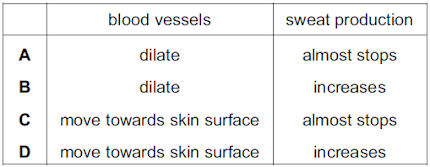IGCSE Paper 1and 2 questions on Characteristics and classification of living organisms
1) The diagram illustrates some of the processes carried out by living organisms.
Which characteristic of living organisms is represented by arrow X?
A excretion
B nutrition
C respiration
D sensitivity
2) What is a correct way of naming a species, according to the binomial system?
A Homo sapiens
B Homo Sapiens
C human being
D sapiens
3) The diagram shows four arthropods.
How many of these arthropods are insects?
A 1 B 2 C 3 D 4
4) The key can be used to distinguish between four different chemical substances.
Use the key to identify which substance could be a protein.
1 contains the element carbon ........................................... go to 2
does not contain carbon .................................................. A
2 contains the element nitrogen ......................................... B
does not contain nitrogen ............................................... go to 3
3 gives a positive result with Benedict’s test ...................... C
gives a negative result with Benedict’s test .................... D
5) All fish, all birds and all mammals are
A animals with internal fertilisation.
B carnivores.
C vertebrates.
D warm-blooded animals.
6) The statements describe four different plants.
Which plant must be a monocotyledon?
A The flowers are wind-pollinated.
B The flowers each have five petals.
C The leaves are large with a clear network of veins on them.
D The leaves have parallel veins.
7) The diagram shows an animal.
Use the key to identify the animal.
1 has two wings ...................................................... go to 2
has four wings ..................................................... go to 3
2 has antennae much shorter than legs ................. A
has antennae about the same length as legs ...... B
3 has feathery antennae ......................................... C
has smooth antennae .......................................... D
8) The diagram shows an animal.
Use the key to identify this animal.
1 body covered with scales ...................... go to 2
body covered with hair .......................... go to 3
2 has a rounded bill .................................. A
has a pointed bill ................................... B
3 has webbed feet .................................... C
does not have webbed feet ................... D
9) The diagram shows a leaf on a plant.
Which characteristic of life is represented by this diagram?
A excretion
B nutrition
C respiration
D sensitivity
10) The diagram shows how Homo sapiens (modern people) could have evolved from earlier ancestors.
Which statement about modern people and their ancestors is correct?
A They are in the same species and the same genus.
B They are in the same species but not the same genus.
C They are in the same genus but not the same species.
D They are neither the same species nor the same genus.
11) The diagram shows an insect.
What is the insect?
1 insect has no wings ........................................... go to 2
insect has wings ................................................ go to 3
2 legs longer than, or as long as the body ........... A
legs shorter than the body ................................. B
3 abdomen long and thin ...................................... C
abdomen shorter and wider ............................... D
12) Which characteristic do all living organisms show?
A breathing
B excretion
C photosynthesis
D tropism
13) The diagram shows some animal cells, as seen under the microscope.
What will be present at X?
A one cell membrane
B one cell wall
C two cell membranes
D two cell walls
14) The diagram shows an animal.
What is the animal?
1 animal with a vertebral column ....................................... vertebrate
animal with an exoskeleton ............................................ go to 2
2 no distinct head, thorax and abdomen ........................... A
distinct head, thorax and abdomen ................................ go to 3
3 eye occupies less than one third of the head ................. B
eye occupies more than one third of the head ................ go to 4
4 wings are wider than they are long ................................. C
wings are longer than they are wide ............................... D
15) Some yeast, sugar and water are mixed in a test-tube. The diagrams show the test-tube at the start and after one hour.
16) Which process causes this change?
A growth
B reproduction
C respiration
D sensitivity
17) Which name is given to a group of individuals that can reproduce to produce fertile offspring?
A a genus
B a kingdom
C a species
D an organ system
18) Use the key to identify the animal shown in the diagram.














I want the answer pls
ReplyDelete